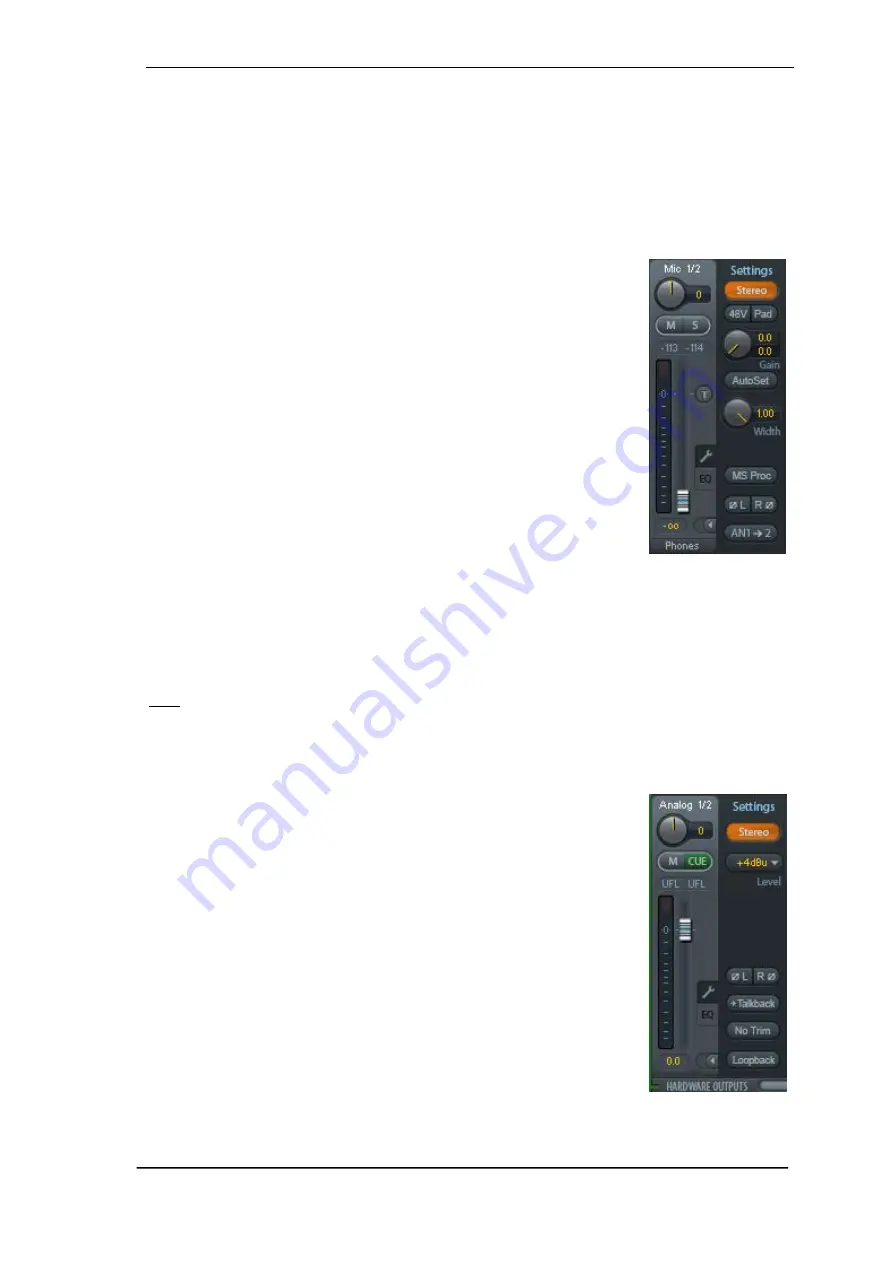
User's Guide Digiface AES
©
RME
53
24.3.1 Settings
A click on the tool symbol opens the channel’s
Settings
panel with differing elements, respective
to the channel’s format.
Stereo.
Switches the channel to mono or stereo mode.
48V.
Only for Mic 1/2. Activates phantom power at the corresponding input. Serves as power
supply for high quality condenser mics. This option should stay off with other sources to prevent
failure by spikes.
PAD.
Only for Mic 1/2. Applies -11 dB damping for the XLR input signal.
Also increases the input impedance.
Gain.
Only for Mic 1/2. Sets the gain for the four front inputs. The knob can
be adjusted by dragging the mouse or by the mouse wheel. This also
works when the mouse has been moved over the two gain displays. Then
the gain can be changed separately for left and right channel, even when
the channel is in stereo mode.
AutoSet.
Only for Mic 1/2. Activates an automatic gain reduction prevent-
ing overloads caused by too high gain settings. See chapter 19 for details.
Width.
Defines the stereo width. 1.00 equals full stereo, 0.00 mono, -1.00
swapped channels.
MS Proc.
Activates M/S processing within the stereo channel. Monaural
information is sent to the left channel, stereo information to the right.
Phase L,
Phase R.
Inverts the phase of the left or right channel by 180°.
AN1
→ 2.
Available only in stereo mode of the Mic 1/2 input pair. Copies the signal of input channel
Mic/Line 1 (analog 1) to channel Mic/Line 2 (analog 2). Typical application: A microphone should
be audible on both channels of a stereo recording.
Note: the functions Width, MS Proc, Phase L, Phase R and
AN1→ 2 affect all routings of the
respective channel.
The settings of the Hardware Outputs have further options:
Level.
Sets the reference levels of the analog outputs. Analog 1/2: +4 dBu,
+13 dBu, +19 dBu. Phones: Low (+7 dBu), High (+13 dBu).
Talkback.
Activates this channel as receiver and output of the Talkback
signal. This way Talkback can be sent to any outputs, not only the Phones
in the Control Room section. Another application could be to send a certain
signal to specific outputs by the push of a button.
No Trim.
Sometimes channels need to have a fixed routing and level,
which should not be changed in any case. An example is the stereo mix-
down for recording of a live show. With
No Trim
active, the routing to this
output channel is excluded from the Trim Gains function, therefore is not
changed unintentionally.
Loopback.
Sends the output data to the driver as record data. The corre-
sponding submix can be recorded then. This channel’s hardware input
sends its data only to TotalMix, no longer to the recording software.
Содержание Digiface AES
Страница 7: ...User s Guide Digiface AES RME 7 User s Guide Digiface AES General...
Страница 13: ...User s Guide Digiface AES RME 13 5 4 Overview Menu Structure...
Страница 15: ...User s Guide Digiface AES RME 15 User s Guide Digiface AES Installation and Operation Windows...
Страница 29: ...User s Guide Digiface AES RME 29 User s Guide Digiface AES Installation and Operation Mac OS X...
Страница 37: ...User s Guide Digiface AES RME 37 User s Guide Digiface AES Inputs and Outputs...
Страница 42: ...42 User s Guide Digiface AES RME...
Страница 43: ...User s Guide Digiface AES RME 43 User s Guide Digiface AES Stand Alone Operation...
Страница 46: ...46 User s Guide Digiface AES RME...
Страница 47: ...User s Guide Digiface AES RME 47 User s Guide Digiface AES TotalMix FX...
Страница 49: ...User s Guide Digiface AES RME 49...
Страница 82: ...82 User s Guide Digiface AES RME...
Страница 83: ...User s Guide Digiface AES RME 83 User s Guide Digiface AES Class Compliant Mode...
Страница 89: ...User s Guide Digiface AES RME 89 User s Guide Digiface AES Technical Reference...
Страница 98: ...98 User s Guide Digiface AES RME 39 Diagrams 39 1 Block Diagram Digiface AES...
Страница 100: ...100 User s Guide Digiface AES RME...
Страница 101: ...User s Guide Digiface AES RME 101 User s Guide Digiface AES Miscellaneous...















































